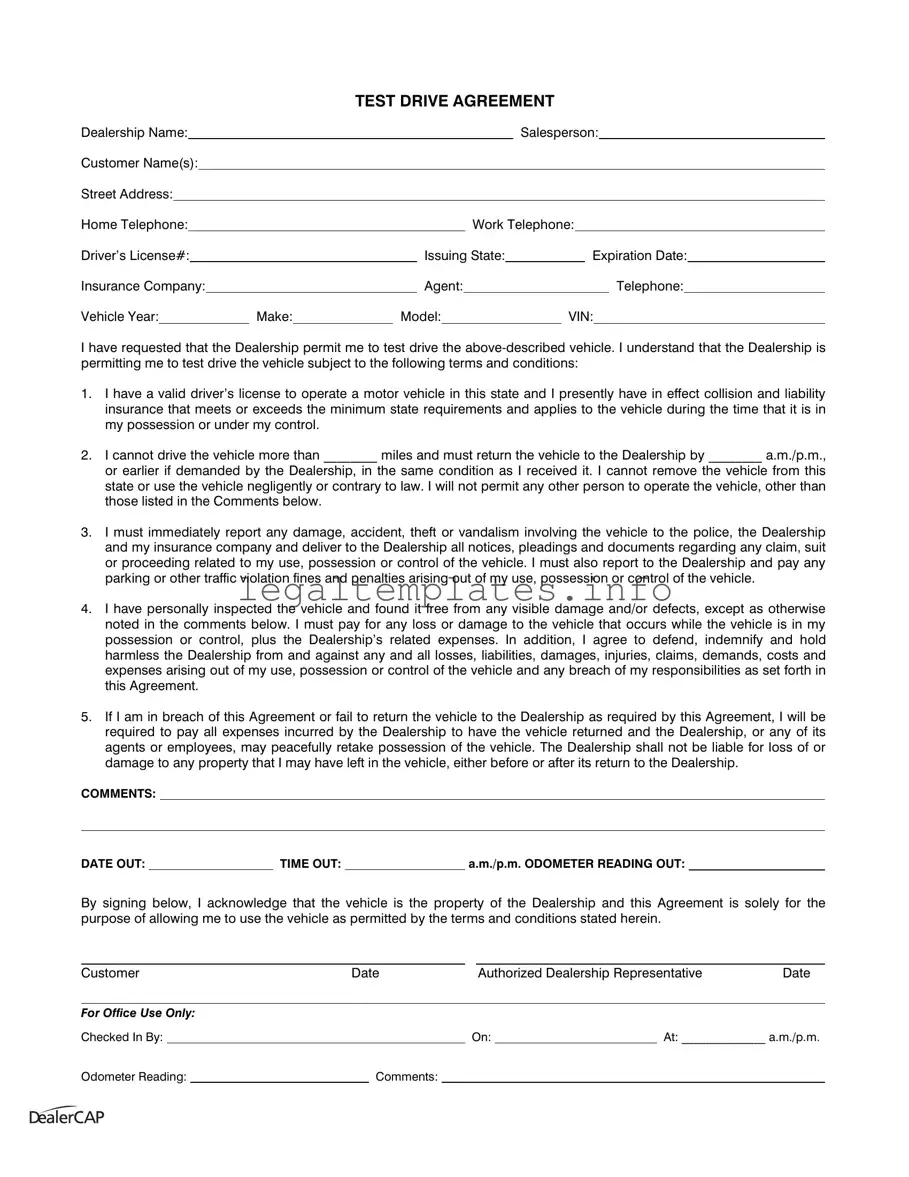The Test Drive Agreement shares similarities with a Car Rental Agreement. Both documents outline terms and conditions under which a vehicle is temporarily entrusted to someone. In both cases, the user must have a valid driver's license and insurance, there are restrictions on vehicle use, including geographic limitations and prohibitions against negligent use, and the user is responsible for reporting accidents and paying for any damages or fines incurred during the period of use. The emphasis on returning the vehicle in the same condition and by a specific time further aligns the two documents in ensuring the temporary custodian adheres to the agreement’s stipulations.
Another document resembling the Test Drive Agreement is the Equipment Loan Agreement. This agreement also temporarily transfers the use of property (in this case, equipment instead of a vehicle) from the owner to another party. Similarities include the requirement for the borrower to maintain the equipment in good condition, report any damages, and possibly even insure the equipment against loss or damage. The borrower is usually held accountable for any mishandling or damages, mirroring the responsibilities outlined in a Test Drive Agreement.
A Liability Waiver Form also parallels the Test Drive Agreement in certain aspects. Both documents require the signer to acknowledge and accept specific risks associated with the activity (driving or otherwise) and often include clauses that indemnify the providing party (the dealership or event organizer) against claims arising from misuse or accidents. While a Liability Waiver often focuses on releasing the provider from legal liability, both types of documents protect the interests of the provider by clearly stating the responsibilities and risks assumed by the user or participant.
The Lease Agreement, particularly for vehicles, shares common ground with the Test Drive Agreement. Both agreements detail the conditions under which a vehicle is used by someone other than the owner, including insurance requirements, usage limitations, and the obligation to return the vehicle in good condition. The key difference lies in the duration of use and purpose, with a lease typically covering long-term use and a test drive being short-term. Despite this, the fundamental principles of vehicle custody and care under specified conditions remain consistent.
A Sales Contract, especially for expensive items like vehicles, bears resemblance in its structure and purpose. Both documents stipulate conditions related to the care and custody of the vehicle, albeit with the Sales Contract culminating in ownership transfer. Elements such as inspection of the vehicle for defects, the obligation to report and address damages, and clauses related to the breach of agreement are present in both, underlining the necessity of clear terms to govern the transaction or use period.
The User Agreement, often found with software or service subscriptions, while not dealing with physical property, similarly outlines terms of use, restrictions, user responsibilities, and the consequences of violations. Just like in a Test Drive Agreement, users must adhere to specified guidelines to maintain access or use rights, with violations potentially leading to termination of the agreement or additional charges, reflective of the breach clauses in a Test Drive Agreement.
An Event Venue Rental Agreement is another document similar to a Test Drive Agreement in many respects. This type of agreement details the terms under which a property (in this case, venue space) is used temporarily. Similarities include the requirement to maintain the property's condition, adhere to use restrictions, and assume liability for damages or legal issues that arise from misuse during the rental period. Both agreements make the temporary custodian responsible for the property’s care and legal compliance during their use.
Lastly, a Loan Agreement, particularly a secured loan that involves physical assets as collateral, can resemble the Test Drive Agreement. While primarily focused on financial transactions, the Loan Agreement also includes conditions regarding the maintenance and insurance of the collateral, much like how a vehicle must be insured and maintained in a Test Drive Agreement. The borrower's obligation to protect the asset’s value and integrity until the loan is repaid or the vehicle is returned aligns with the temporary custodian's responsibilities in a Test Drive Agreement.

